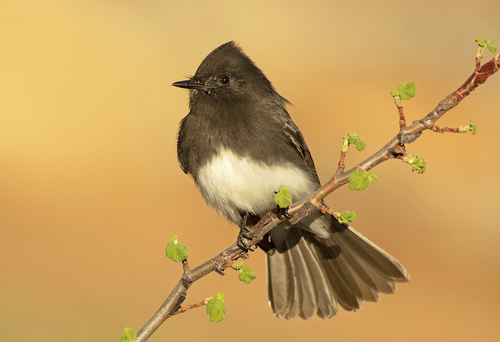
Black Phoebe
The Black Phoebe (Sayornis nigricans) is a striking, small passerine bird known for its characteristic tail-wagging behavior and preference for habitats near water. It plays an important ecological role as an insectivore, helping to control insect populations. While not typically considered a bird of significant cultural importance, its bold nature and proximity to human settlements often make it a familiar and welcome sight.
14-18 cm
Length
28-30 cm
Wingspan
Least Concern
Conservation Status
Distribution
The Black Phoebe's range extends from the southwestern United States through Mexico and Central America, and into parts of South America, including Colombia, Ecuador, and Peru. It is generally non-migratory, though some populations may make short altitudinal movements.
Lifespan
Up to 8 years in the wild, though typical lifespan is shorter.
Black Phoebe's Habitat
Habitat Types
Streamsides, Ponds, Lakes, Coastal cliffs, Urban parks with water features
Climate Zones
Temperate, Subtropical, Tropical
Adaptations
Black Phoebes are often found near water sources, reflecting their dependence on flying insects that frequent these areas. They have adapted to human-altered landscapes and often nest on buildings or bridges near water.
Variations
Several subspecies are recognized, differing slightly in plumage darkness and size, reflecting geographic isolation.
Appearance
Breeding Plumage
Plumage is generally consistent year-round.
Seasonal Feather Changes
No significant seasonal variation.
Sex Based Plumage Differences
Males and females have similar plumage: sooty black overall with a white belly and undertail coverts.
Notable Features
Constant tail-wagging, White belly contrasting with black upperparts, Slightly peaked crown
Diet and Feeding
Primary Foods
Flying insects, Small beetles, Wasps, Flies, Dragonflies
Foraging Behavior
Black Phoebes are primarily 'sally' hunters, perching on low branches or rocks near water and darting out to catch insects in mid-air. They also glean insects from foliage or the ground.
Specializations
Their hunting style is adapted to open areas near water where flying insects are abundant.
Seasonal Diet Variations
Diet remains relatively consistent year-round, though the specific insect species consumed may vary with seasonal availability.
Behavior
Social Structure
Black Phoebes are generally solitary or found in pairs, especially during the breeding season.
Communication
A distinctive 'tsip' call, A sputtering song consisting of repeated phrases, Tail-wagging, likely used in territorial displays and communication
Migration
Mostly non-migratory, though some populations at higher elevations may move to lower elevations in winter.
Territorial or Group Behaviors
Black Phoebes are highly territorial, defending their nesting and feeding areas from other phoebes and sometimes other bird species.
Conservation
Threats
Habitat loss due to urbanization and water pollution, Pesticide use affecting insect prey, Climate change, potentially altering insect emergence patterns
Protection Programs
General protections under the Migratory Bird Treaty Act in the US, Habitat restoration projects in some areas
Local National Laws
Protected under the Migratory Bird Treaty Act in the United States.
Population Trend
Stable
Population Estimates
Global population estimated to be around 6 million individuals.
Interesting Facts
They often reuse nests from previous years.
This saves time and energy during the breeding season.
They are known to nest on human-made structures.
This adaptability has allowed them to thrive in urban environments.
They can catch insects directly from the water's surface.
This behavior is less common but demonstrates their foraging versatility.
Faqs about Black Phoebe
What is the purpose of the Black Phoebe's tail-wagging?
The exact purpose is not fully understood, but it may be related to territorial displays, communication, or balance while perching.
Are Black Phoebes aggressive?
They can be aggressive towards other birds when defending their territory, but they are generally not aggressive towards humans.
Do Black Phoebes migrate?
Most populations are non-migratory, but some may move short distances altitudinally in response to weather conditions.
What should I do if I find a baby Black Phoebe?
It's best to leave it alone unless it's clearly injured or in immediate danger. The parents are likely nearby. If you are concerned contact a local wildlife rehabilitator. *Consult a professional for expert advice*
Copyright @ Nature Style Limited. All Rights Reserved.
 English
English